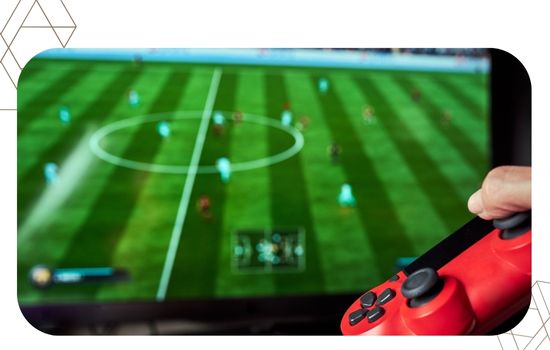Advertisements
Soccer games: the passion for sports in digital format have become a global phenomenon that combines emotion, strategy and technology.

It's not just a form of entertainment, but a reflection of the competitive spirit that defines the most popular sport on the planet.
From next-generation consoles to mobile simulators, these games have transformed the way millions experience their love of soccer.
In this article, you'll discover how soccer games have evolved, their most influential titles, their impact on sports culture, and where the industry is headed in 2025.
We'll also explore how artificial intelligence, augmented reality, and eSports have taken this passion to the next level.
Advertisements
The digital evolution of football
From the pixelated games of the FIFA International Soccer (1993) to the hyperrealistic experiences of the EA Sports FC 25, the Soccer games: the passion for sports in digital format have come a long way.
What began as a technological experiment is now a multi-billion-dollar industry that moves emotions and entire communities.
Graphics technology, physics engines, and improvements in artificial intelligence have made the movements, reactions, and strategies of virtual players increasingly similar to human behavior.
A game on a console or PC can feel so real that many fans feel the same adrenaline rush as they would in a stadium.
A report from Newzoo 2024 reveals that 27% of gamers in Latin America play sports titles, and within this segment, soccer represents more than 65% of preference.
This figure demonstrates how the king of sports also dominates the digital landscape.
The emotional power of football on screen
Playing soccer on a console or online isn't just a competition; it's a form of expression.
The user does not control a character, but rather lives a football identity.
Who hasn't celebrated a goal in their living room as if it were a World Cup final?
That emotional connection is what keeps the flame alive.
In the Soccer games: the passion for sports in digital format, the details matter: stadium music, realistic storytelling, personalized celebrations, and career modes that let you create a unique story.
Example 1: A young man can start managing a modest club in the second division and, with dedication and strategy, lead it to international glory.
This journey, full of decisions, tactics and emotions, reflects the spirit of the real sport.
Technological innovation: artificial intelligence and extreme realism
In 2025, the sports video game industry is entering a new era driven by artificial intelligence.
Machine learning engines analyze millions of real-life plays to replicate the team styles, attacking patterns, and decisions of the most renowned footballers.
For example, the EA Sports FC 25 introduced the “PlayStyles+” system, which allows each virtual player to mimic the running, feinting, or passing style of their real-life counterpart.
These types of advancements not only enhance the viewing experience, but also teach the user about tactics and strategy.
The integration of augmented reality and virtual reality opens up an even more immersive field.
It's now possible to train penalty kicks or free kicks in 3D environments with VR headsets, literally feeling the pressure of a packed stadium.
Analogy: Just as football unites people from different cultures under a single emotional banner, digital games do the same in the virtual world, connecting millions of minds through a shared passion.
Community, competition and global culture
The rise of eSports consolidated the Soccer games: the passion for sports in digital format as a professional discipline.
Leagues like the eLaLiga Santander wave FIFAe World Cup They prove that digital talent can be as acclaimed as physical talent.
Live broadcasts, international tournaments, and social media amplify the reach of these events, generating audiences in the millions.
On platforms like Twitch and YouTube, thousands of content creators stream their matches, tactical analysis, and career mode challenges.
Example 2: A Mexican player who started uploading FIFA videos is now an official commentator for eSports tournaments and a collaborator for sports brands.
His story reflects how passion can transform into a profession.
The industry and its economic impact
According to Statista 2025, the global sports video game market will exceed $7.8 billion this year, driven mainly by football titles.
The combination of microtransactions, season passes, and online competitions generates stable, recurring revenue for game developers.
Below is a table with real-world data on the evolution of revenue by sports genre in video games:
| Year | Global revenue (USD) | % Football on total |
|---|---|---|
| 2021 | 5.2 billion | 58% |
| 2023 | 6.9 billion | 63% |
| 2025 | 7.8 billion | 66% |
These numbers confirm that digital football is not a passing fad, but a solid trend that will continue to grow alongside immersive technologies.

Read more: History of the first video games
Education and analysis through play
Far from being just a distraction, the Soccer games: the passion for sports in digital format have an educational value.
Many coaches and analysts use simulators to study formations, test strategies, and evaluate tactical behaviors without ever having to step onto the field.
Gamified training programs are even being developed for young soccer players, where game logic helps them better understand the dynamics of real-life sports.
This connection between virtual practice and physical reality expands the boundaries of sports learning.
Digital responsibility and balance
It's not all about competition and fun. With the growth of gaming comes the need to promote responsible habits.
Maintaining a balance between play, study, and physical activity is essential, especially at early ages.
Leading franchises in the industry have implemented parental controls, rest reminders, and time limits, demonstrating their commitment to user well-being.
In a world where technology is ubiquitous, this awareness makes the difference between healthy entertainment and digital dependence.
Future of football games
The horizon is promising.
The coming years are expected to include even more personalized experiences, where players can create stadiums, clubs, and competitions with extreme realism.
Cross-platform interoperability will allow the global community to participate without hardware or location barriers.
Predictive AI could analyze a user's playing style to automatically adjust difficulty or suggest personalized strategies.
In essence, the video game will learn from the player, not the other way around.
This type of innovation strengthens the emotional connection and consolidates digital football as a pillar of contemporary entertainment culture.
Conclusion
The expansion of the Soccer games: the passion for sports in digital format demonstrates how technology can amplify human emotion.
More than a hobby, they represent a modern way of experiencing sports, learning from them, and sharing them with millions around the world.
The fusion of artificial intelligence, community, and sports emotion defines a new era where the line between reality and virtuality becomes increasingly thinner.
In this scenario, the ball keeps rolling, only now it does so on the digital circuits that connect an entire generation.
Read more: Evolution of car simulators
Frequently Asked Questions
1. What is the most popular soccer game in 2025?
He EA Sports FC 25 leads the market with improvements in AI and realism, followed by eFootball 2025 from Konami.
2. Can football games improve real tactical knowledge?
Yes. Many players and coaches use simulators to analyze strategies and understand game patterns.
3. What is the difference between traditional games and virtual reality games?
The immersion.
In virtual reality, the user participates as if they were on the field, while in traditional games they control from an external perspective.
4. How do eSports affect the football industry?
They foster connections between fans and brands, open up job opportunities, and expand the visibility of sports beyond the physical stadium.



